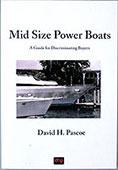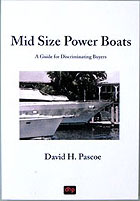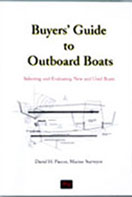Sea Ray 268
by David Pascoe
Our survey model was a 1987 boat with a single Mercruiser 330/sterndrive which, judging from the lack of fading on the red gel coat had been kept in undercover dry storage most of its life. This boat was being brokered by a dealer and it was quite obvious that a lot of "make-ready" had gone into it, everything from polishing the gel coat to the spray can overhaul of the engine.
We'll start with the point that there were only 280 hours showing on the meter (no, it wasn't broken) but the single engine was kaput. Sea water cooled and 10 years and that was about it. First, it had one new exhaust manifold but two new risers. Typical of the way things are done, why replace both of them when you can risk the other one going bad soon and wrecking your engine? Well, that's just what happened.
A compression test brought in readings around 90 psi. Yet in looking at the head gaskets, we could see that they were leaking - in fact water was streaming out of the rear of one of the heads on sea trial, which was cut short because of this. The boat was in decent shape otherwise and we advised the client that he should renegotiate for a rebuild, which he did. Which brings us to the point that we inspected the rebuild in progress for the client (smart move by him) to make sure that it was done right. Once torn down, we found out that the cam shaft was bad and that had to be replaced too. In addition, it was found that the after market gaskets for the exhaust risers weren't sized right so that the risers were leaking water back into the engine, even though they had just been replaced.
We've never cared much for the way Sea Ray builds their hulls because they basically box in their stringers - making a shelf between the outboard stringer and the chine - and generally close off the rest of the interior so that you can't see what's going on with the internal hull. Thus, if something is breaking apart, you're not likely to see it. In this instance, we found some light stress cracking on the port side bottom amidships along the the strake, but on the inside there was no access at all.
The hull sides are poorly supported -- if at all -- and there was some crazing on the sides as well. The worst structural weakness was showing up at the hull/deck joint where the slamming stresses are transferred to the screwed together joint, breaking the screws loose and loosening the rails. All along the port side they were loose. The bow pulpit apparently had been impacted and the deck was fractured around it, particularly at the deck joint. This is just plain lousy engineering and the intention of the builder to save on labor costs. In fact, we've seen other 27's considerably worse than this one.
The interior is your basic fur-lined glove with carpet glued all over everything, including the inside of the hull. This one's also got the 8' long windows in the side which are the only thing that holds up the deck. Jump on it and you bend the window frames and they start leaking with no hope of stopping it. The owner of this one had caulked the windows shut to try to stop the leaks.
There was a water line 6" above the cabin sole aft. That's because the cabin sole is literally on the bottom of the hull. The owner had built some kind of coffer dam into which he installed one of those Rule aquarium pumps (which is about all they're good for) to try to solve the problem of there only being one bilge pump in the boat, and that being located under the engine. Of course, when you slow down suddenly, all that water in the bilge which the pump won't remove runs forward and . . . .well, you know. Messes up the carpet a bit, among other things.
We weren't too amused at an engine hatch that was so big that it takes up the entire cockpit space. What's wrong with that? Well, try lifting up a hatch when you're standing on it! There's no other place to stand. More good design. Would have been more amusing if we weren't trying to do a survey on it.
To make matters worse, the hatch has a gutter on it that is too shallow. Blast it with a hose while washing down, or get some heavy rain, and water goes all over everything in the engine compartment. The battery charger was rusted out and most everything else down there looked pretty shabby, including some pretty sloppy original installations with hoses poorly routed, things generally hard to reach, and wiring that was less than neat. Beware that when you're looking at boats with engines under a cockpit deck, if that hatch is not designed to keep water out, there's no end to the problems and damage that can result. The hatch gutters should be deep and have large drains that won't easily plug up with debris. If the gutter overflows, guess where the water goes?
Downright absurd was the fact that, while underway, the cockpit scuppers on the side of the hull were catching water and jetting it right up the drain hoses and onto the engine hatch. Now we know why the battery charger was completely rusted out.
The performance was generally good. Unfortunately, we had a dead flat calm day out on the Gulf Stream, but the shape of this hull guarantees that its not going to ride well in a chop. For some reason, it isn't as squirrely as many stern drive boats can be. And those awful Mercruiser controls? What gear are we in? Well, throttle up to find out! Is the handle going to break off? Sure feels like it.
This is a pretty good example of why we said in the introduction that we were rather ambivalent about SeaRay. With only a bit more forethought and effort, this could have been a decent boat. It certainly looks good, and makes good use of the space, but there's just too much corner cutting and obvious cost cutting on these boats to really give it a thumbs up. The original price tag was over $40k and was selling for well under twenty. This, for a boat that does not look clapped out. Sea Rays don't come with an entry level price tag, nor do they aspire to that. Instead, it falls somewhere between the good and the ugly. Its fair value at what she's selling for at today's prices, but you have to put up with a lot of stupid design problems that will eventually cost you more.
Oh, yes. We might add that when you launch this boat from a trailer . . . . the engine fills up with water through the exhaust. That's a danger you'll face with launching any boat this size from a trailer. Not a good idea.
 Visit davidpascoe.com for his power boat books
Visit davidpascoe.com for his power boat books 














David Pascoe is a second generation marine surveyor in his family who began his surveying career at age 16 as an apprentice in 1965 as the era of wooden boats was drawing to a close.
Certified by the National Association of Marine Surveyors in 1972, he has conducted over 5,000 pre purchase surveys in addition to having conducted hundreds of boating accident investigations, including fires, sinkings, hull failures and machinery failure analysis.
Over forty years of knowledge and experience are brought to bear in following books. David Pascoe is the author of:
In addition to readers in the United States, boaters and boat industry professionals worldwide from nearly 80 countries have purchased David Pascoe's books, since introduction of his first book in 2001.
In 2012, David Pascoe has retired from marine surveying business at age 65.
On November 23rd, 2018, David Pascoe has passed away at age 71.
Biography - Long version